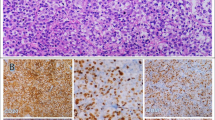Abstract
Diffuse large B cell lymphoma (DLBCL) is a heterogeneous group of B cell lymphomas. MicroRNA expression provides a new and interesting tool for understanding the biology and clinical course of DLBCL. The present study presents microRNA-129-5p expression data from DLBCL patients treated with CHOP or R-CHOP. Patients with low microRNA-129-5p expression had a median survival of 23 months and a significantly shorter overall survival (P = 0.0042) compared to patients with high microRNA-129-5p expression, who had a median survival of 58 months. We also found that patients treated with R-CHOP only and displaying low microRNA-129-5p expression had a significantly shorter overall survival compared to patients with high microRNA-129-5p expression; all such patients were still alive at the time of last follow-up (P = 0.043). No significant difference was found among microRNA-129-5p expression in tumor tissue, the tissue surrounding the tumor, and normal controls. To our knowledge, this is the first report to show that the expression of microRNA-129-5p can affect the clinical outcome of DLBCL patients and that microRNA-129-5p may be involved in the biology of DLBCL development, although larger studies are necessary to confirm this. Further investigations may also help to elucidate the biological role of microRNA-129-5p in DLBCL.



Similar content being viewed by others
References
Habermann TM, et al. Rituximab-CHOP versus CHOP alone or with maintenance rituximab in older patients with diffuse large B-cell lymphoma. J Clin Oncol. 2006;24(19):3121–7.
Rosenwald A, et al. The use of molecular profiling to predict survival after chemotherapy for diffuse large-B-cell lymphoma. New Engl J Med. 2002;346(25):1937–47.
Alizadeh AA, et al. Distinct types of diffuse large B-cell lymphoma identified by gene expression profiling. Nature. 2000;403(6769):503–11.
Ninan MJ, Wadhwa PD, Gupta P. Prognostication of diffuse large B-cell lymphoma in the rituximab era. Leuk lymphoma. 2011;52(3):360–73.
Kim VN, Han J, Siomi MC. Biogenesis of small RNAs in animals. Nat Rev Mol Cell Biol. 2009;10(2):126–39.
Valencia-Sanchez MA, et al. Control of translation and mRNA degradation by miRNAs and siRNAs. Genes Dev. 2006;20(5):515–24.
Davis-Dusenbery BN, Hata A. MicroRNA in cancer: the involvement of aberrant microrna biogenesis regulatory pathways. Genes Cancer. 2010;1(11):1100–14.
Hobert O. Common logic of transcription factor and microRNA action. Trends Biochem Sci. 2004;29(9):462–8.
Alencar AJ, et al. MicroRNAs are independent predictors of outcome in diffuse large B-cell lymphoma patients treated with R-CHOP. Clin Cancer Res. 2011;17(12):4125–35.
Calin GA, et al. A MicroRNA signature associated with prognosis and progression in chronic lymphocytic leukemia. New Engl J Med. 2005;353(17):1793–801.
Marcucci G, et al. MicroRNA expression in cytogenetically normal acute myeloid leukemia. New Engl J Med. 2008;358(18):1919–28.
Montes-Moreno S, et al. miRNA expression in diffuse large B-cell lymphoma treated with chemoimmunotherapy. Blood. 2011;118(4):1034–40.
Schwind S, et al. Prognostic significance of expression of a single microRNA, miR-181a, in cytogenetically normal acute myeloid leukemia: a cancer and leukemia group B study. J Clin Oncol. 2010;28(36):5257–64.
Yanaihara N, et al. Unique microRNA molecular profiles in lung cancer diagnosis and prognosis. Cancer Cell. 2006;9(3):189–98.
Liao R, et al. MicroRNAs play a role in the development of human hematopoietic stem cells. J Cell Biochem. 2008;104(3):805–17.
Wu J, et al. miR-129 regulates cell proliferation by downregulating Cdk6 expression. Cell Cycle. 2010;9(9):1809–18.
Huang YW, et al. Epigenetic repression of microRNA-129-2 leads to overexpression of SOX4 oncogene in endometrial cancer. Cancer Res. 2009;69(23):9038–46.
Nicoloso MS, et al. MicroRNAs–the micro steering wheel of tumour metastases. Nat Rev Cancer. 2009;9(4):293–302.
Shen R, et al. Epigenetic repression of microRNA-129-2 leads to overexpression of SOX4 in gastric cancer. Biochem Biophys Res Commun. 2010;394(4):1047–52.
Tsai KW, et al. Epigenetic regulation of miR-34b and miR-129 expression in gastric cancer. Int J Cancer. 2011;129(11):2600–10.
Dyrskjot L, et al. Genomic profiling of microRNAs in bladder cancer: miR-129 is associated with poor outcome and promotes cell death in vitro. Cancer Res. 2009;69(11):4851–60.
Hans CP, et al. Confirmation of the molecular classification of diffuse large B-cell lymphoma by immunohistochemistry using a tissue microarray. Blood. 2004;103(1):275–82.
Pfaffl MW. A new mathematical model for relative quantification in real-time RT-PCR. Nucleic Acids Res. 2001;29(9):e45.
Lawrie CH, et al. Expression of microRNAs in diffuse large B cell lymphoma is associated with immunophenotype, survival and transformation from follicular lymphoma. J Cell Mol Med. 2009;13(7):1248–60.
Castillo JJ, et al. The Hans algorithm is not prognostic in patients with diffuse large B-cell lymphoma treated with R-CHOP. Leuk Res. 2012;36(4):413–7.
Choi WW, et al. A new immunostain algorithm classifies diffuse large B-cell lymphoma into molecular subtypes with high accuracy. Clin Cancer Res. 2009;15(17):5494–502.
Meyer SU, et al. Profound effect of profiling platform and normalization strategy on detection of differentially expressed microRNAs–a comparative study. PLoS ONE. 2012;7(6):e38946.
Katada T, et al. microRNA expression profile in undifferentiated gastric cancer. Int J Oncol. 2009;34(2):537–42.
Tavazoie SF, et al. Endogenous human microRNAs that suppress breast cancer metastasis. Nature. 2008;451(7175):147–52.
Menon MP, Pittaluga S, Jaffe ES. The histological and biological spectrum of diffuse large B-cell lymphoma in the World Health Organization classification. Cancer J. 2012;18(5):411–20.
Swerdlow SH, et al. WHO classification of tumours of haematopoietic and lymphoid tissues. In: WHO classification of tumours, vol. 22008, 4th ed. Lyon: WHO; 2008. p. 439.
Castillo JJ, et al. Epstein-barr virus-positive diffuse large B-cell lymphoma of the elderly: what we know so far. Oncologist. 2011;16(1):87–96.
Hoeller S, et al. Epstein-Barr virus-positive diffuse large B-cell lymphoma in elderly patients is rare in Western populations. Hum Pathol. 2010;41(3):352–7.
Kim JH, Kim WS, Park C. Epstein-Barr virus latent membrane protein-1 protects B-cell lymphoma from rituximab-induced apoptosis through miR-155-mediated Akt activation and up-regulation of Mcl-1. Leuk Lymphoma. 2012;53(8):1586–91.
Rosato P, et al. Differential regulation of miR-21 and miR-146a by Epstein-Barr virus-encoded EBNA2. Leukemia. 2012;26(11):2343–52.
Conflict of interest
The authors declare that they have no conflict of interest.
Author information
Authors and Affiliations
Corresponding author
Additional information
G. Hedström and U. Thunberg have contributed equally as first authors.
About this article
Cite this article
Hedström, G., Thunberg, U., Berglund, M. et al. Low expression of microRNA-129-5p predicts poor clinical outcome in diffuse large B cell lymphoma (DLBCL). Int J Hematol 97, 465–471 (2013). https://doi.org/10.1007/s12185-013-1303-2
Received:
Revised:
Accepted:
Published:
Issue Date:
DOI: https://doi.org/10.1007/s12185-013-1303-2




